Nike's Supply Chain Management: Structure, Processes, and Analysis
VerifiedAdded on 2023/03/17
|18
|4442
|72
Report
AI Summary
This report provides a comprehensive analysis of Nike's supply chain management. It begins with an introduction to Nike's business, products, and financial position, highlighting its global presence and reliance on an effective supply chain. The report then delves into the existing supply chain structure, emphasizing its outsourcing policy and the forward integration with various channel partners. It examines Nike's distribution channels, including intensive and exclusive distribution strategies, along with their respective advantages and limitations. Furthermore, the report explores contracts within the supply chain, particularly those with third-party manufacturers and retailers. The analysis extends to sourcing materials, production processes, and service design, along with suggestions for improvement, such as adopting a "just-in-time" approach. The report also discusses the distribution system of Nike's major customers, detailing their lean manufacturing and distribution systems. Finally, the report covers likeness management and inventory systems, providing a holistic view of Nike's supply chain operations and potential areas for enhancement.
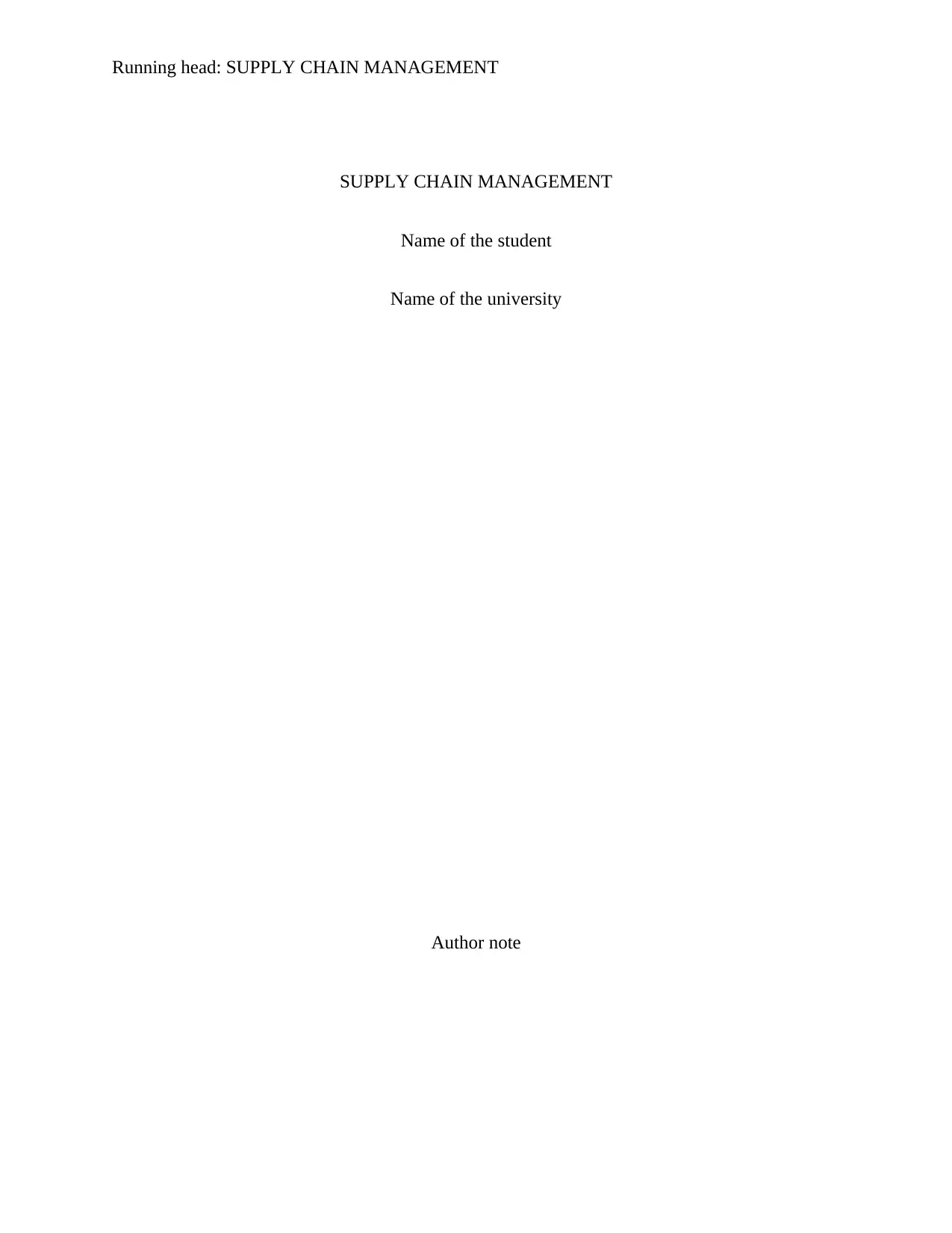
Running head: SUPPLY CHAIN MANAGEMENT
SUPPLY CHAIN MANAGEMENT
Name of the student
Name of the university
Author note
SUPPLY CHAIN MANAGEMENT
Name of the student
Name of the university
Author note
Paraphrase This Document
Need a fresh take? Get an instant paraphrase of this document with our AI Paraphraser
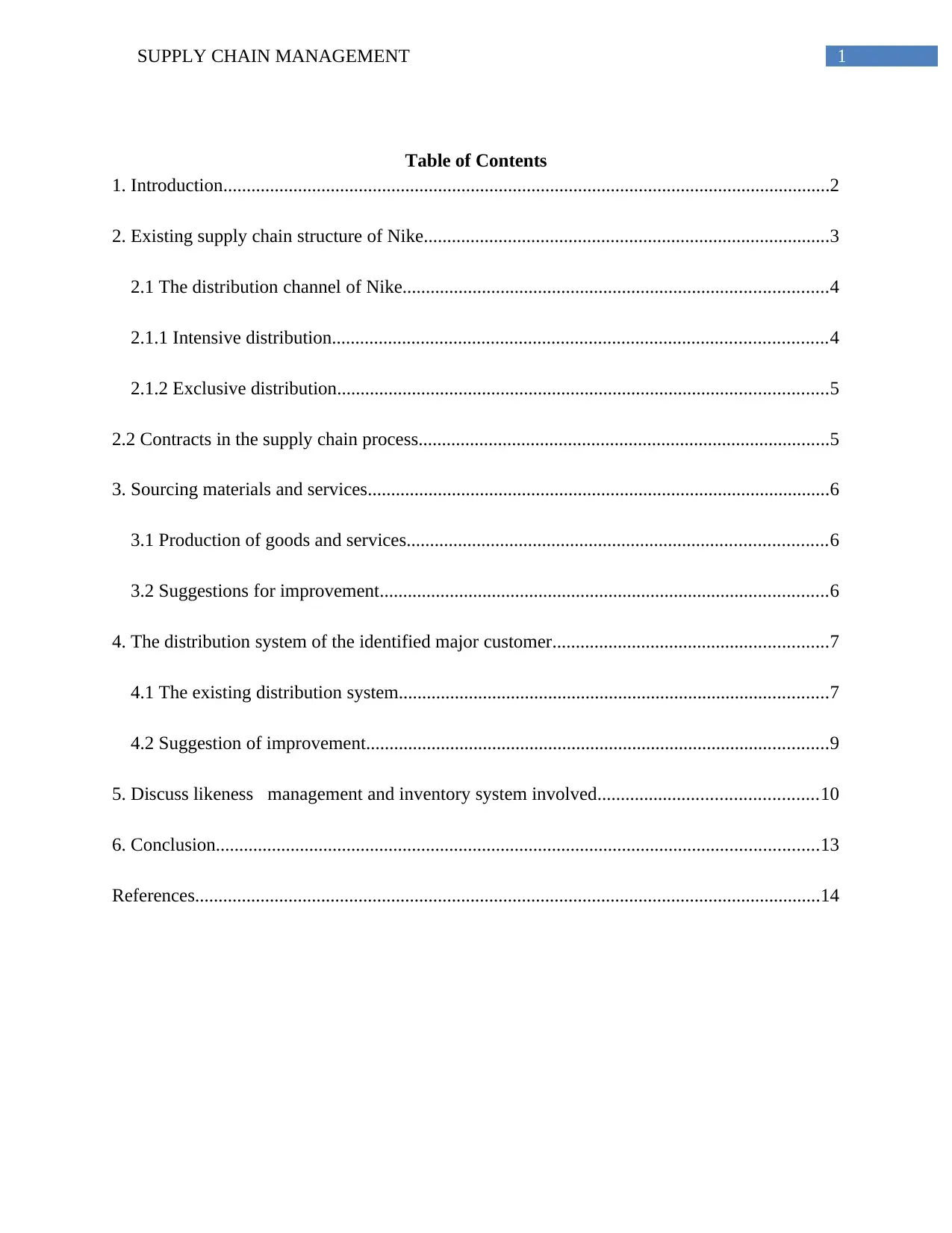
1SUPPLY CHAIN MANAGEMENT
Table of Contents
1. Introduction..................................................................................................................................2
2. Existing supply chain structure of Nike.......................................................................................3
2.1 The distribution channel of Nike...........................................................................................4
2.1.1 Intensive distribution..........................................................................................................4
2.1.2 Exclusive distribution.........................................................................................................5
2.2 Contracts in the supply chain process........................................................................................5
3. Sourcing materials and services...................................................................................................6
3.1 Production of goods and services..........................................................................................6
3.2 Suggestions for improvement................................................................................................6
4. The distribution system of the identified major customer...........................................................7
4.1 The existing distribution system............................................................................................7
4.2 Suggestion of improvement...................................................................................................9
5. Discuss likeness management and inventory system involved...............................................10
6. Conclusion.................................................................................................................................13
References......................................................................................................................................14
Table of Contents
1. Introduction..................................................................................................................................2
2. Existing supply chain structure of Nike.......................................................................................3
2.1 The distribution channel of Nike...........................................................................................4
2.1.1 Intensive distribution..........................................................................................................4
2.1.2 Exclusive distribution.........................................................................................................5
2.2 Contracts in the supply chain process........................................................................................5
3. Sourcing materials and services...................................................................................................6
3.1 Production of goods and services..........................................................................................6
3.2 Suggestions for improvement................................................................................................6
4. The distribution system of the identified major customer...........................................................7
4.1 The existing distribution system............................................................................................7
4.2 Suggestion of improvement...................................................................................................9
5. Discuss likeness management and inventory system involved...............................................10
6. Conclusion.................................................................................................................................13
References......................................................................................................................................14
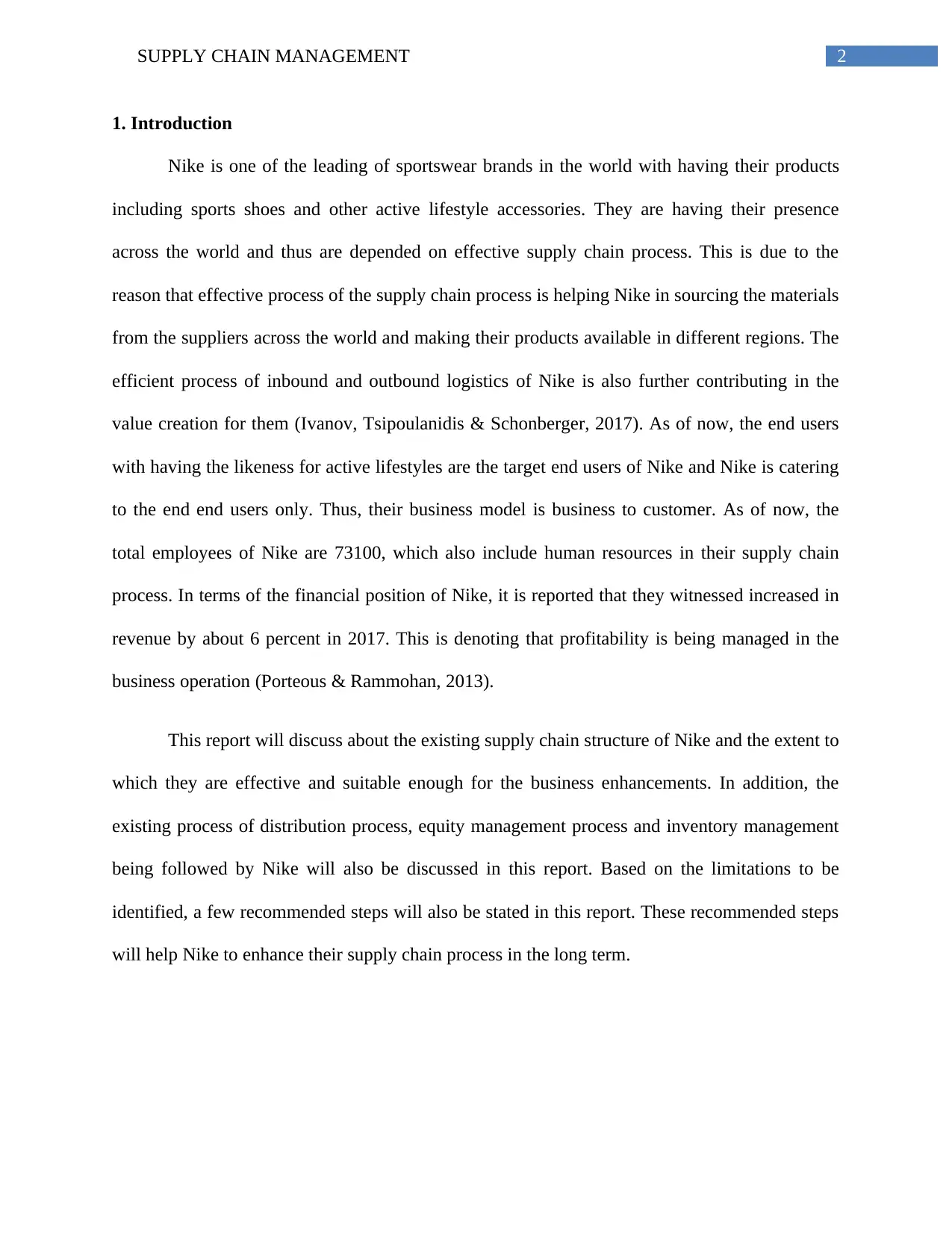
2SUPPLY CHAIN MANAGEMENT
1. Introduction
Nike is one of the leading of sportswear brands in the world with having their products
including sports shoes and other active lifestyle accessories. They are having their presence
across the world and thus are depended on effective supply chain process. This is due to the
reason that effective process of the supply chain process is helping Nike in sourcing the materials
from the suppliers across the world and making their products available in different regions. The
efficient process of inbound and outbound logistics of Nike is also further contributing in the
value creation for them (Ivanov, Tsipoulanidis & Schonberger, 2017). As of now, the end users
with having the likeness for active lifestyles are the target end users of Nike and Nike is catering
to the end end users only. Thus, their business model is business to customer. As of now, the
total employees of Nike are 73100, which also include human resources in their supply chain
process. In terms of the financial position of Nike, it is reported that they witnessed increased in
revenue by about 6 percent in 2017. This is denoting that profitability is being managed in the
business operation (Porteous & Rammohan, 2013).
This report will discuss about the existing supply chain structure of Nike and the extent to
which they are effective and suitable enough for the business enhancements. In addition, the
existing process of distribution process, equity management process and inventory management
being followed by Nike will also be discussed in this report. Based on the limitations to be
identified, a few recommended steps will also be stated in this report. These recommended steps
will help Nike to enhance their supply chain process in the long term.
1. Introduction
Nike is one of the leading of sportswear brands in the world with having their products
including sports shoes and other active lifestyle accessories. They are having their presence
across the world and thus are depended on effective supply chain process. This is due to the
reason that effective process of the supply chain process is helping Nike in sourcing the materials
from the suppliers across the world and making their products available in different regions. The
efficient process of inbound and outbound logistics of Nike is also further contributing in the
value creation for them (Ivanov, Tsipoulanidis & Schonberger, 2017). As of now, the end users
with having the likeness for active lifestyles are the target end users of Nike and Nike is catering
to the end end users only. Thus, their business model is business to customer. As of now, the
total employees of Nike are 73100, which also include human resources in their supply chain
process. In terms of the financial position of Nike, it is reported that they witnessed increased in
revenue by about 6 percent in 2017. This is denoting that profitability is being managed in the
business operation (Porteous & Rammohan, 2013).
This report will discuss about the existing supply chain structure of Nike and the extent to
which they are effective and suitable enough for the business enhancements. In addition, the
existing process of distribution process, equity management process and inventory management
being followed by Nike will also be discussed in this report. Based on the limitations to be
identified, a few recommended steps will also be stated in this report. These recommended steps
will help Nike to enhance their supply chain process in the long term.
⊘ This is a preview!⊘
Do you want full access?
Subscribe today to unlock all pages.

Trusted by 1+ million students worldwide
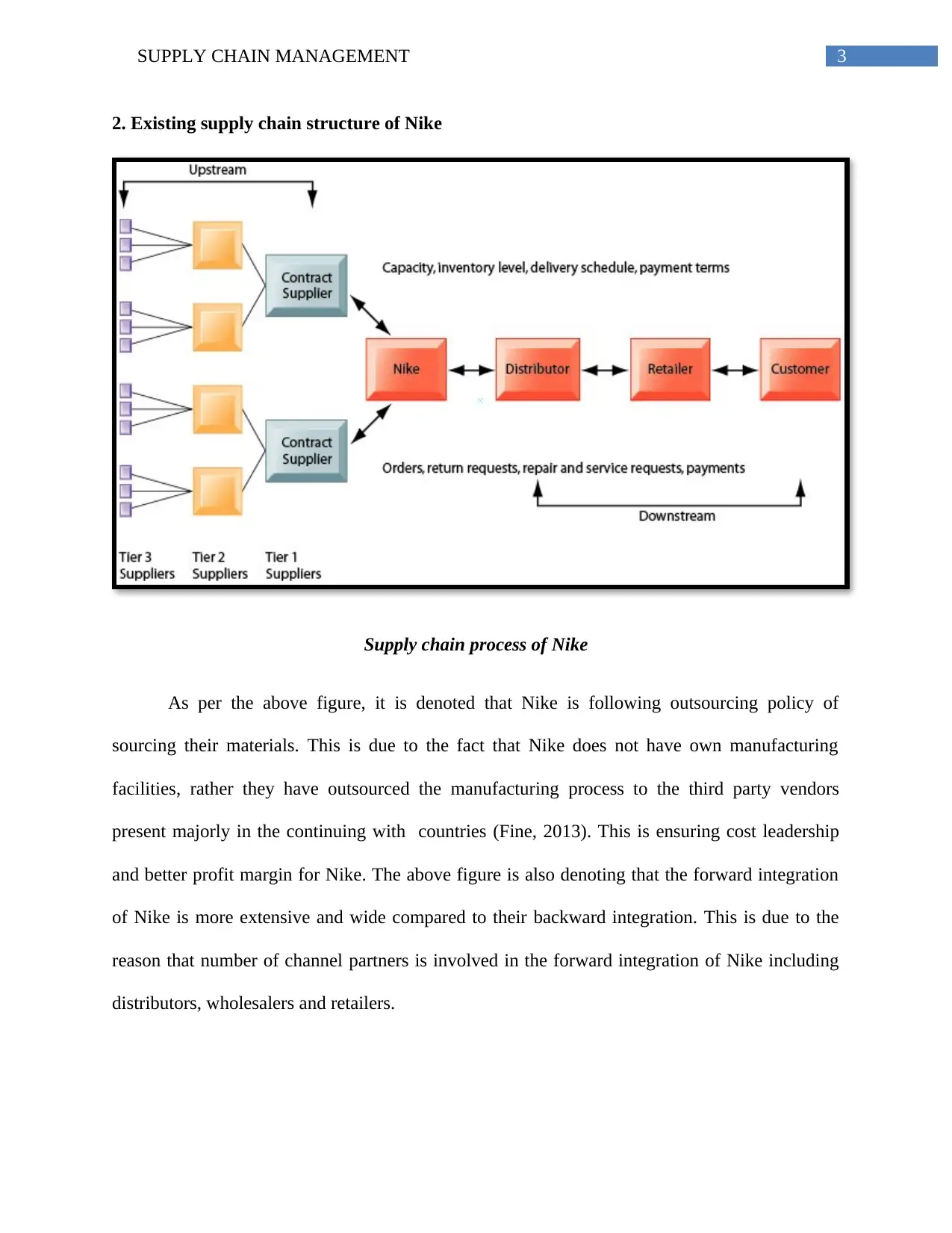
3SUPPLY CHAIN MANAGEMENT
2. Existing supply chain structure of Nike
Supply chain process of Nike
As per the above figure, it is denoted that Nike is following outsourcing policy of
sourcing their materials. This is due to the fact that Nike does not have own manufacturing
facilities, rather they have outsourced the manufacturing process to the third party vendors
present majorly in the continuing with countries (Fine, 2013). This is ensuring cost leadership
and better profit margin for Nike. The above figure is also denoting that the forward integration
of Nike is more extensive and wide compared to their backward integration. This is due to the
reason that number of channel partners is involved in the forward integration of Nike including
distributors, wholesalers and retailers.
2. Existing supply chain structure of Nike
Supply chain process of Nike
As per the above figure, it is denoted that Nike is following outsourcing policy of
sourcing their materials. This is due to the fact that Nike does not have own manufacturing
facilities, rather they have outsourced the manufacturing process to the third party vendors
present majorly in the continuing with countries (Fine, 2013). This is ensuring cost leadership
and better profit margin for Nike. The above figure is also denoting that the forward integration
of Nike is more extensive and wide compared to their backward integration. This is due to the
reason that number of channel partners is involved in the forward integration of Nike including
distributors, wholesalers and retailers.
Paraphrase This Document
Need a fresh take? Get an instant paraphrase of this document with our AI Paraphraser
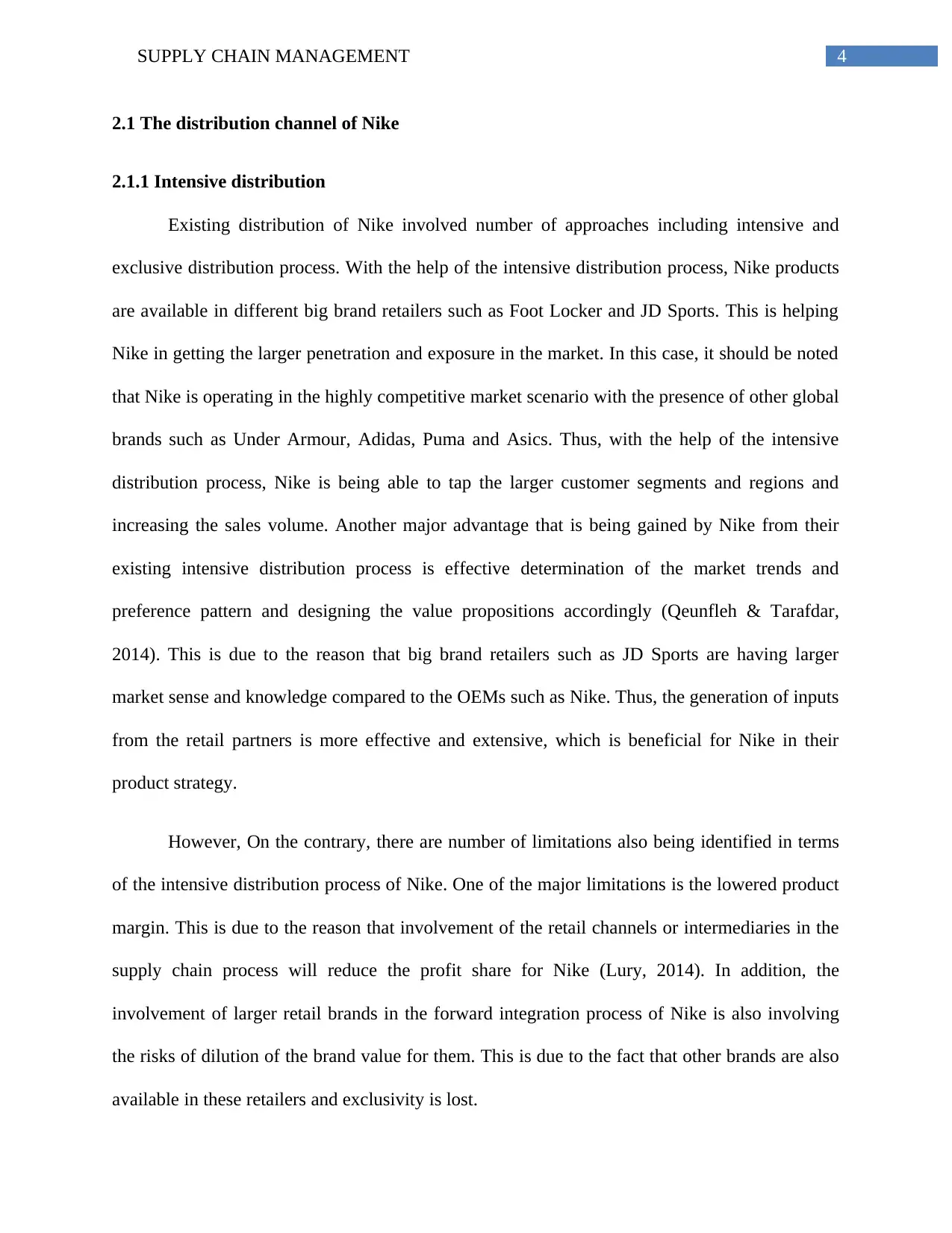
4SUPPLY CHAIN MANAGEMENT
2.1 The distribution channel of Nike
2.1.1 Intensive distribution
Existing distribution of Nike involved number of approaches including intensive and
exclusive distribution process. With the help of the intensive distribution process, Nike products
are available in different big brand retailers such as Foot Locker and JD Sports. This is helping
Nike in getting the larger penetration and exposure in the market. In this case, it should be noted
that Nike is operating in the highly competitive market scenario with the presence of other global
brands such as Under Armour, Adidas, Puma and Asics. Thus, with the help of the intensive
distribution process, Nike is being able to tap the larger customer segments and regions and
increasing the sales volume. Another major advantage that is being gained by Nike from their
existing intensive distribution process is effective determination of the market trends and
preference pattern and designing the value propositions accordingly (Qeunfleh & Tarafdar,
2014). This is due to the reason that big brand retailers such as JD Sports are having larger
market sense and knowledge compared to the OEMs such as Nike. Thus, the generation of inputs
from the retail partners is more effective and extensive, which is beneficial for Nike in their
product strategy.
However, On the contrary, there are number of limitations also being identified in terms
of the intensive distribution process of Nike. One of the major limitations is the lowered product
margin. This is due to the reason that involvement of the retail channels or intermediaries in the
supply chain process will reduce the profit share for Nike (Lury, 2014). In addition, the
involvement of larger retail brands in the forward integration process of Nike is also involving
the risks of dilution of the brand value for them. This is due to the fact that other brands are also
available in these retailers and exclusivity is lost.
2.1 The distribution channel of Nike
2.1.1 Intensive distribution
Existing distribution of Nike involved number of approaches including intensive and
exclusive distribution process. With the help of the intensive distribution process, Nike products
are available in different big brand retailers such as Foot Locker and JD Sports. This is helping
Nike in getting the larger penetration and exposure in the market. In this case, it should be noted
that Nike is operating in the highly competitive market scenario with the presence of other global
brands such as Under Armour, Adidas, Puma and Asics. Thus, with the help of the intensive
distribution process, Nike is being able to tap the larger customer segments and regions and
increasing the sales volume. Another major advantage that is being gained by Nike from their
existing intensive distribution process is effective determination of the market trends and
preference pattern and designing the value propositions accordingly (Qeunfleh & Tarafdar,
2014). This is due to the reason that big brand retailers such as JD Sports are having larger
market sense and knowledge compared to the OEMs such as Nike. Thus, the generation of inputs
from the retail partners is more effective and extensive, which is beneficial for Nike in their
product strategy.
However, On the contrary, there are number of limitations also being identified in terms
of the intensive distribution process of Nike. One of the major limitations is the lowered product
margin. This is due to the reason that involvement of the retail channels or intermediaries in the
supply chain process will reduce the profit share for Nike (Lury, 2014). In addition, the
involvement of larger retail brands in the forward integration process of Nike is also involving
the risks of dilution of the brand value for them. This is due to the fact that other brands are also
available in these retailers and exclusivity is lost.
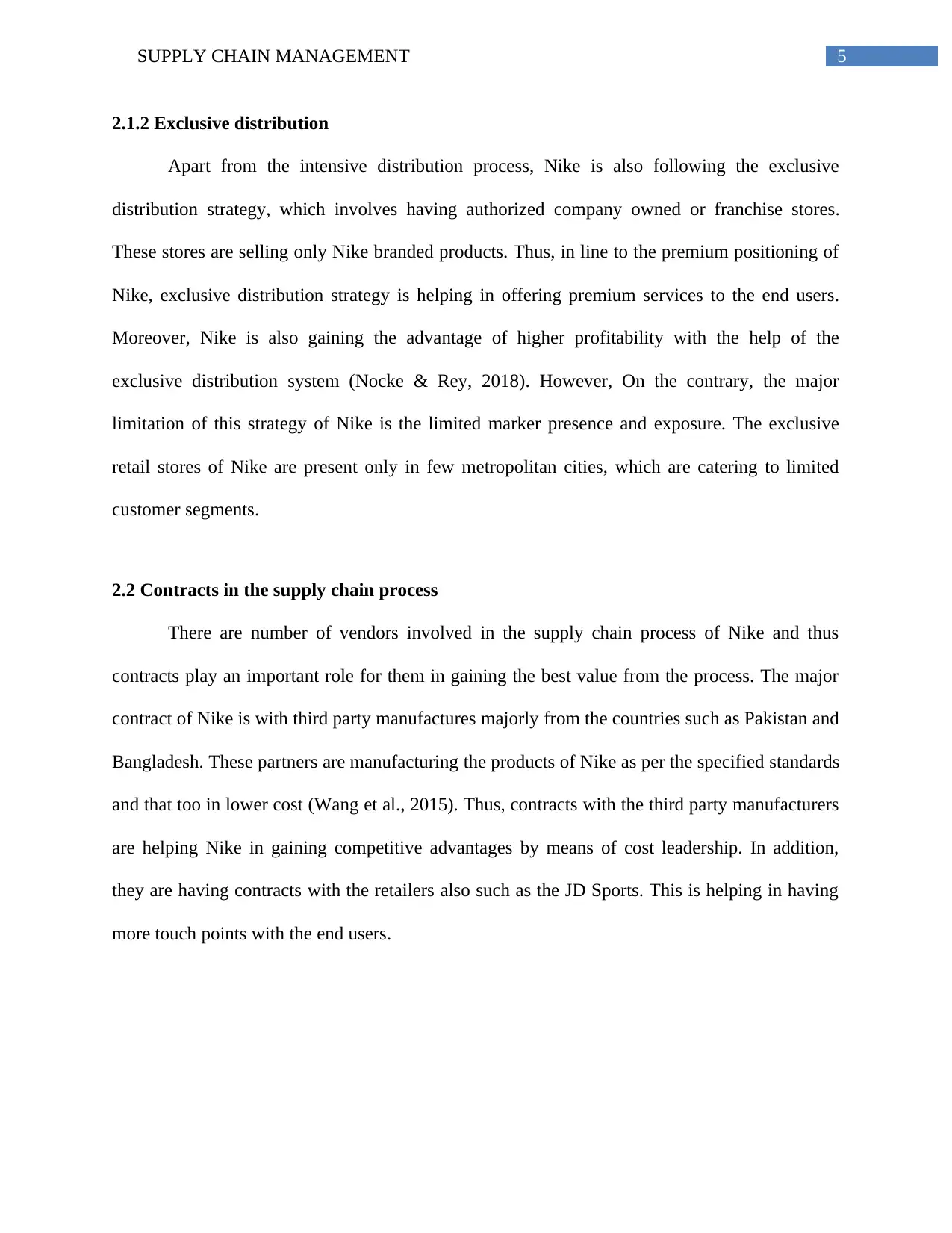
5SUPPLY CHAIN MANAGEMENT
2.1.2 Exclusive distribution
Apart from the intensive distribution process, Nike is also following the exclusive
distribution strategy, which involves having authorized company owned or franchise stores.
These stores are selling only Nike branded products. Thus, in line to the premium positioning of
Nike, exclusive distribution strategy is helping in offering premium services to the end users.
Moreover, Nike is also gaining the advantage of higher profitability with the help of the
exclusive distribution system (Nocke & Rey, 2018). However, On the contrary, the major
limitation of this strategy of Nike is the limited marker presence and exposure. The exclusive
retail stores of Nike are present only in few metropolitan cities, which are catering to limited
customer segments.
2.2 Contracts in the supply chain process
There are number of vendors involved in the supply chain process of Nike and thus
contracts play an important role for them in gaining the best value from the process. The major
contract of Nike is with third party manufactures majorly from the countries such as Pakistan and
Bangladesh. These partners are manufacturing the products of Nike as per the specified standards
and that too in lower cost (Wang et al., 2015). Thus, contracts with the third party manufacturers
are helping Nike in gaining competitive advantages by means of cost leadership. In addition,
they are having contracts with the retailers also such as the JD Sports. This is helping in having
more touch points with the end users.
2.1.2 Exclusive distribution
Apart from the intensive distribution process, Nike is also following the exclusive
distribution strategy, which involves having authorized company owned or franchise stores.
These stores are selling only Nike branded products. Thus, in line to the premium positioning of
Nike, exclusive distribution strategy is helping in offering premium services to the end users.
Moreover, Nike is also gaining the advantage of higher profitability with the help of the
exclusive distribution system (Nocke & Rey, 2018). However, On the contrary, the major
limitation of this strategy of Nike is the limited marker presence and exposure. The exclusive
retail stores of Nike are present only in few metropolitan cities, which are catering to limited
customer segments.
2.2 Contracts in the supply chain process
There are number of vendors involved in the supply chain process of Nike and thus
contracts play an important role for them in gaining the best value from the process. The major
contract of Nike is with third party manufactures majorly from the countries such as Pakistan and
Bangladesh. These partners are manufacturing the products of Nike as per the specified standards
and that too in lower cost (Wang et al., 2015). Thus, contracts with the third party manufacturers
are helping Nike in gaining competitive advantages by means of cost leadership. In addition,
they are having contracts with the retailers also such as the JD Sports. This is helping in having
more touch points with the end users.
⊘ This is a preview!⊘
Do you want full access?
Subscribe today to unlock all pages.

Trusted by 1+ million students worldwide
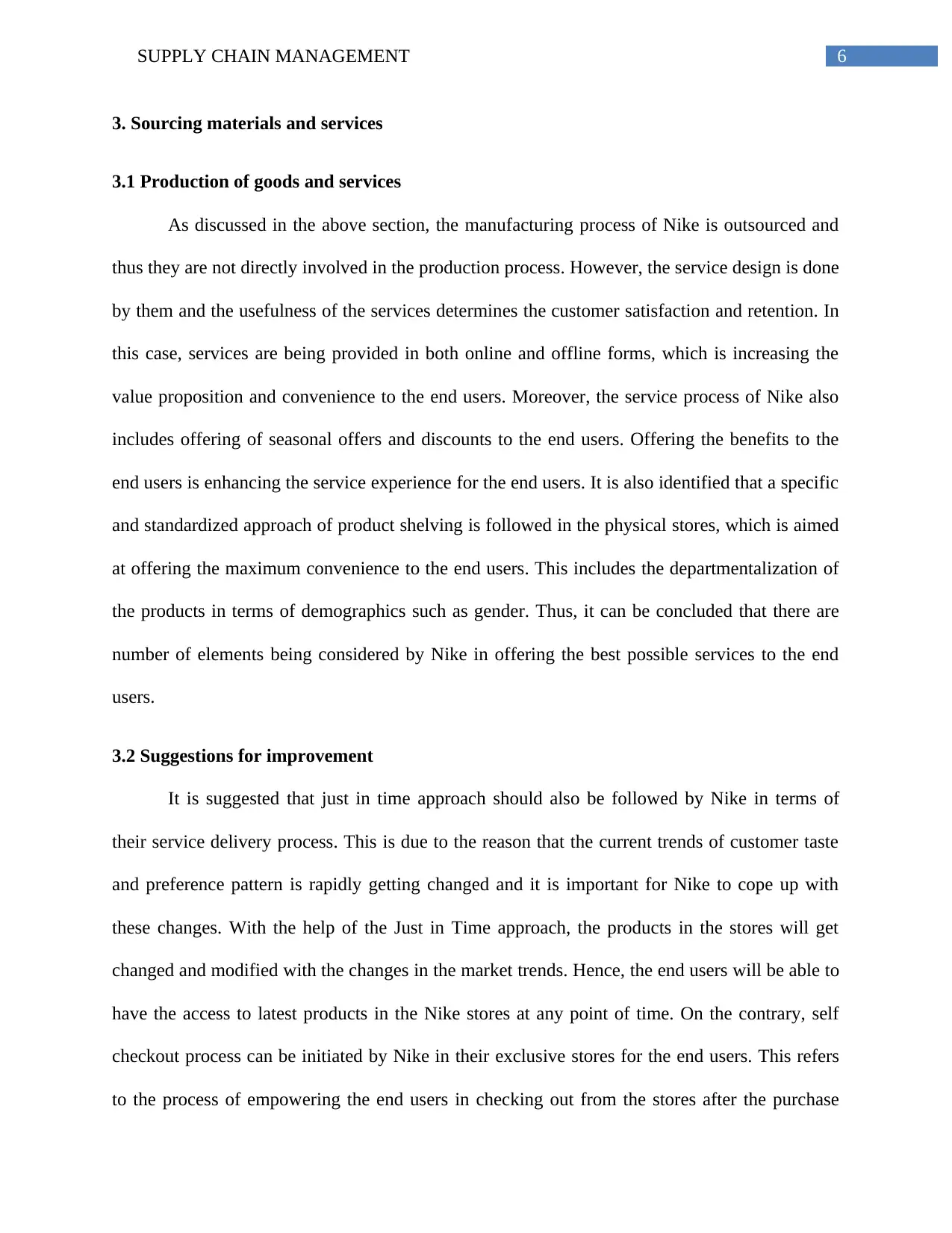
6SUPPLY CHAIN MANAGEMENT
3. Sourcing materials and services
3.1 Production of goods and services
As discussed in the above section, the manufacturing process of Nike is outsourced and
thus they are not directly involved in the production process. However, the service design is done
by them and the usefulness of the services determines the customer satisfaction and retention. In
this case, services are being provided in both online and offline forms, which is increasing the
value proposition and convenience to the end users. Moreover, the service process of Nike also
includes offering of seasonal offers and discounts to the end users. Offering the benefits to the
end users is enhancing the service experience for the end users. It is also identified that a specific
and standardized approach of product shelving is followed in the physical stores, which is aimed
at offering the maximum convenience to the end users. This includes the departmentalization of
the products in terms of demographics such as gender. Thus, it can be concluded that there are
number of elements being considered by Nike in offering the best possible services to the end
users.
3.2 Suggestions for improvement
It is suggested that just in time approach should also be followed by Nike in terms of
their service delivery process. This is due to the reason that the current trends of customer taste
and preference pattern is rapidly getting changed and it is important for Nike to cope up with
these changes. With the help of the Just in Time approach, the products in the stores will get
changed and modified with the changes in the market trends. Hence, the end users will be able to
have the access to latest products in the Nike stores at any point of time. On the contrary, self
checkout process can be initiated by Nike in their exclusive stores for the end users. This refers
to the process of empowering the end users in checking out from the stores after the purchase
3. Sourcing materials and services
3.1 Production of goods and services
As discussed in the above section, the manufacturing process of Nike is outsourced and
thus they are not directly involved in the production process. However, the service design is done
by them and the usefulness of the services determines the customer satisfaction and retention. In
this case, services are being provided in both online and offline forms, which is increasing the
value proposition and convenience to the end users. Moreover, the service process of Nike also
includes offering of seasonal offers and discounts to the end users. Offering the benefits to the
end users is enhancing the service experience for the end users. It is also identified that a specific
and standardized approach of product shelving is followed in the physical stores, which is aimed
at offering the maximum convenience to the end users. This includes the departmentalization of
the products in terms of demographics such as gender. Thus, it can be concluded that there are
number of elements being considered by Nike in offering the best possible services to the end
users.
3.2 Suggestions for improvement
It is suggested that just in time approach should also be followed by Nike in terms of
their service delivery process. This is due to the reason that the current trends of customer taste
and preference pattern is rapidly getting changed and it is important for Nike to cope up with
these changes. With the help of the Just in Time approach, the products in the stores will get
changed and modified with the changes in the market trends. Hence, the end users will be able to
have the access to latest products in the Nike stores at any point of time. On the contrary, self
checkout process can be initiated by Nike in their exclusive stores for the end users. This refers
to the process of empowering the end users in checking out from the stores after the purchase
Paraphrase This Document
Need a fresh take? Get an instant paraphrase of this document with our AI Paraphraser
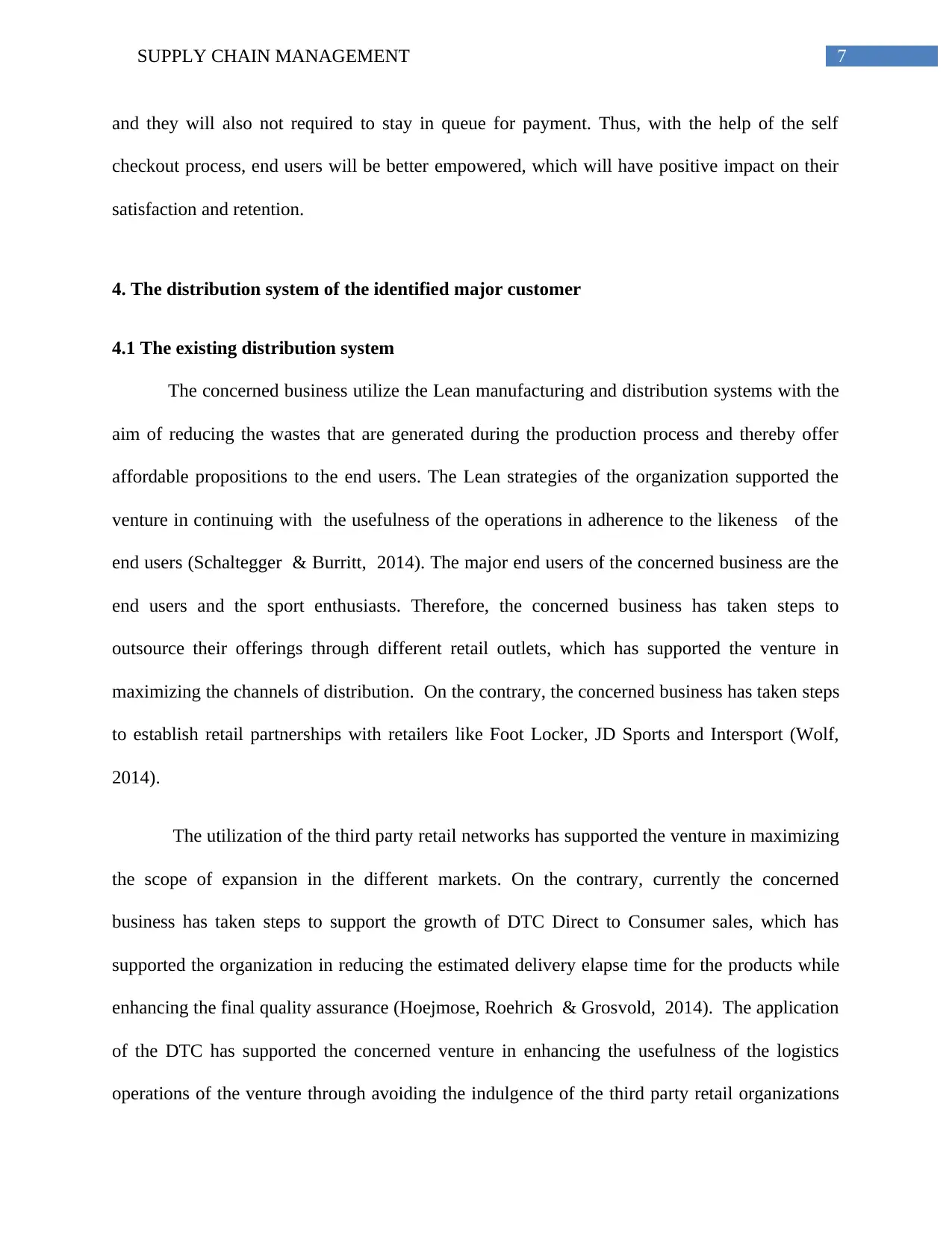
7SUPPLY CHAIN MANAGEMENT
and they will also not required to stay in queue for payment. Thus, with the help of the self
checkout process, end users will be better empowered, which will have positive impact on their
satisfaction and retention.
4. The distribution system of the identified major customer
4.1 The existing distribution system
The concerned business utilize the Lean manufacturing and distribution systems with the
aim of reducing the wastes that are generated during the production process and thereby offer
affordable propositions to the end users. The Lean strategies of the organization supported the
venture in continuing with the usefulness of the operations in adherence to the likeness of the
end users (Schaltegger & Burritt, 2014). The major end users of the concerned business are the
end users and the sport enthusiasts. Therefore, the concerned business has taken steps to
outsource their offerings through different retail outlets, which has supported the venture in
maximizing the channels of distribution. On the contrary, the concerned business has taken steps
to establish retail partnerships with retailers like Foot Locker, JD Sports and Intersport (Wolf,
2014).
The utilization of the third party retail networks has supported the venture in maximizing
the scope of expansion in the different markets. On the contrary, currently the concerned
business has taken steps to support the growth of DTC Direct to Consumer sales, which has
supported the organization in reducing the estimated delivery elapse time for the products while
enhancing the final quality assurance (Hoejmose, Roehrich & Grosvold, 2014). The application
of the DTC has supported the concerned venture in enhancing the usefulness of the logistics
operations of the venture through avoiding the indulgence of the third party retail organizations
and they will also not required to stay in queue for payment. Thus, with the help of the self
checkout process, end users will be better empowered, which will have positive impact on their
satisfaction and retention.
4. The distribution system of the identified major customer
4.1 The existing distribution system
The concerned business utilize the Lean manufacturing and distribution systems with the
aim of reducing the wastes that are generated during the production process and thereby offer
affordable propositions to the end users. The Lean strategies of the organization supported the
venture in continuing with the usefulness of the operations in adherence to the likeness of the
end users (Schaltegger & Burritt, 2014). The major end users of the concerned business are the
end users and the sport enthusiasts. Therefore, the concerned business has taken steps to
outsource their offerings through different retail outlets, which has supported the venture in
maximizing the channels of distribution. On the contrary, the concerned business has taken steps
to establish retail partnerships with retailers like Foot Locker, JD Sports and Intersport (Wolf,
2014).
The utilization of the third party retail networks has supported the venture in maximizing
the scope of expansion in the different markets. On the contrary, currently the concerned
business has taken steps to support the growth of DTC Direct to Consumer sales, which has
supported the organization in reducing the estimated delivery elapse time for the products while
enhancing the final quality assurance (Hoejmose, Roehrich & Grosvold, 2014). The application
of the DTC has supported the concerned venture in enhancing the usefulness of the logistics
operations of the venture through avoiding the indulgence of the third party retail organizations
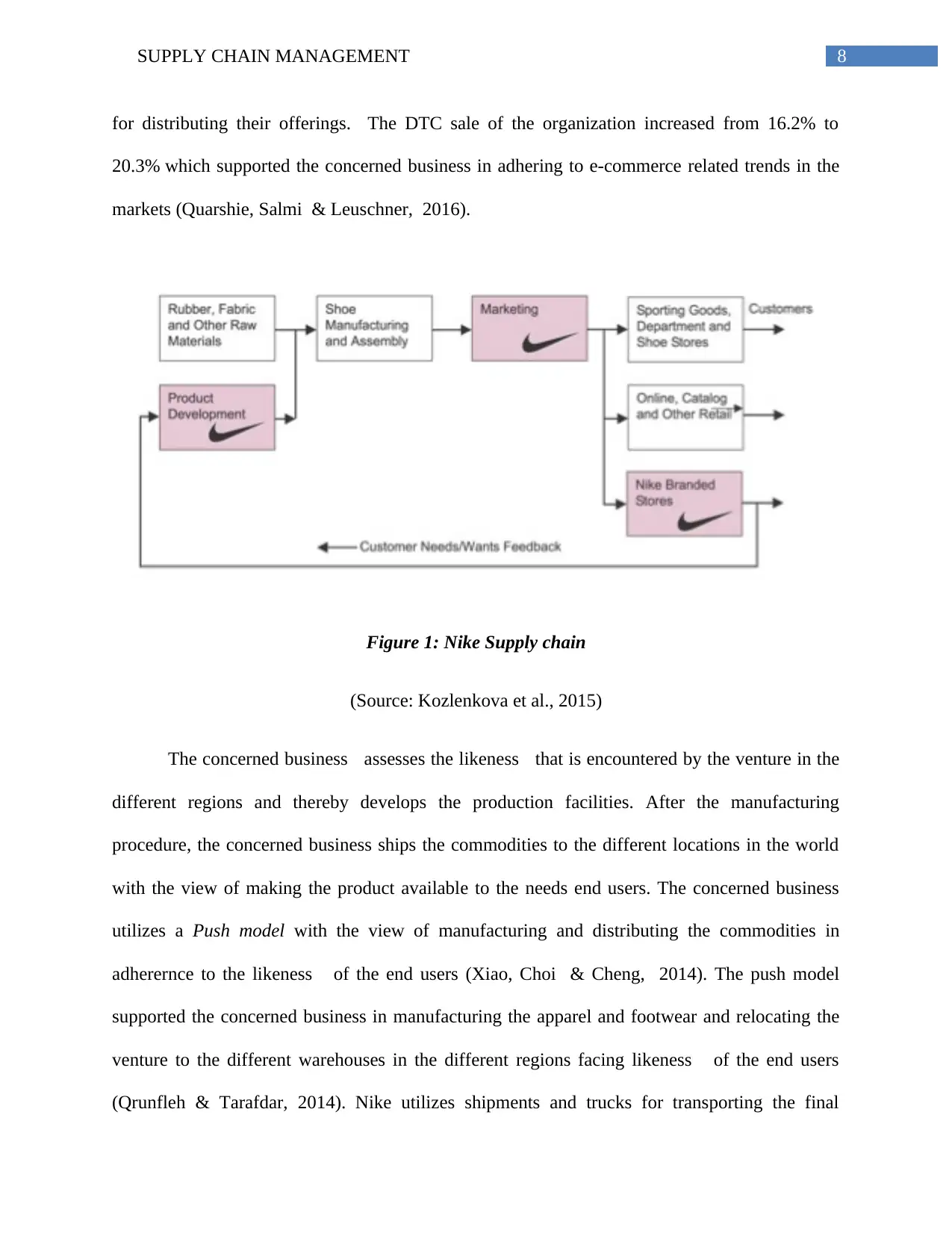
8SUPPLY CHAIN MANAGEMENT
for distributing their offerings. The DTC sale of the organization increased from 16.2% to
20.3% which supported the concerned business in adhering to e-commerce related trends in the
markets (Quarshie, Salmi & Leuschner, 2016).
Figure 1: Nike Supply chain
(Source: Kozlenkova et al., 2015)
The concerned business assesses the likeness that is encountered by the venture in the
different regions and thereby develops the production facilities. After the manufacturing
procedure, the concerned business ships the commodities to the different locations in the world
with the view of making the product available to the needs end users. The concerned business
utilizes a Push model with the view of manufacturing and distributing the commodities in
adherernce to the likeness of the end users (Xiao, Choi & Cheng, 2014). The push model
supported the concerned business in manufacturing the apparel and footwear and relocating the
venture to the different warehouses in the different regions facing likeness of the end users
(Qrunfleh & Tarafdar, 2014). Nike utilizes shipments and trucks for transporting the final
for distributing their offerings. The DTC sale of the organization increased from 16.2% to
20.3% which supported the concerned business in adhering to e-commerce related trends in the
markets (Quarshie, Salmi & Leuschner, 2016).
Figure 1: Nike Supply chain
(Source: Kozlenkova et al., 2015)
The concerned business assesses the likeness that is encountered by the venture in the
different regions and thereby develops the production facilities. After the manufacturing
procedure, the concerned business ships the commodities to the different locations in the world
with the view of making the product available to the needs end users. The concerned business
utilizes a Push model with the view of manufacturing and distributing the commodities in
adherernce to the likeness of the end users (Xiao, Choi & Cheng, 2014). The push model
supported the concerned business in manufacturing the apparel and footwear and relocating the
venture to the different warehouses in the different regions facing likeness of the end users
(Qrunfleh & Tarafdar, 2014). Nike utilizes shipments and trucks for transporting the final
⊘ This is a preview!⊘
Do you want full access?
Subscribe today to unlock all pages.

Trusted by 1+ million students worldwide
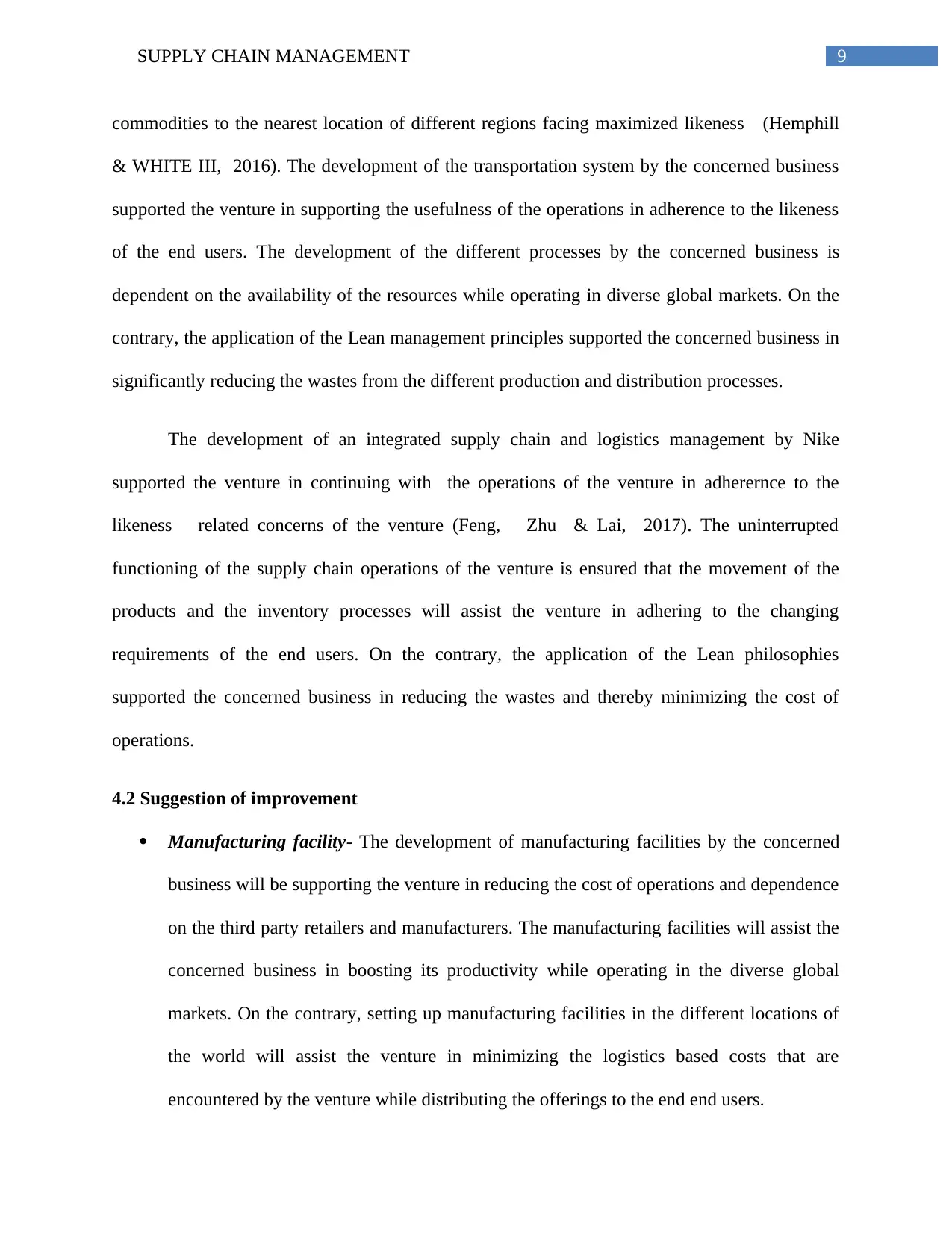
9SUPPLY CHAIN MANAGEMENT
commodities to the nearest location of different regions facing maximized likeness (Hemphill
& WHITE III, 2016). The development of the transportation system by the concerned business
supported the venture in supporting the usefulness of the operations in adherence to the likeness
of the end users. The development of the different processes by the concerned business is
dependent on the availability of the resources while operating in diverse global markets. On the
contrary, the application of the Lean management principles supported the concerned business in
significantly reducing the wastes from the different production and distribution processes.
The development of an integrated supply chain and logistics management by Nike
supported the venture in continuing with the operations of the venture in adherernce to the
likeness related concerns of the venture (Feng, Zhu & Lai, 2017). The uninterrupted
functioning of the supply chain operations of the venture is ensured that the movement of the
products and the inventory processes will assist the venture in adhering to the changing
requirements of the end users. On the contrary, the application of the Lean philosophies
supported the concerned business in reducing the wastes and thereby minimizing the cost of
operations.
4.2 Suggestion of improvement
Manufacturing facility- The development of manufacturing facilities by the concerned
business will be supporting the venture in reducing the cost of operations and dependence
on the third party retailers and manufacturers. The manufacturing facilities will assist the
concerned business in boosting its productivity while operating in the diverse global
markets. On the contrary, setting up manufacturing facilities in the different locations of
the world will assist the venture in minimizing the logistics based costs that are
encountered by the venture while distributing the offerings to the end end users.
commodities to the nearest location of different regions facing maximized likeness (Hemphill
& WHITE III, 2016). The development of the transportation system by the concerned business
supported the venture in supporting the usefulness of the operations in adherence to the likeness
of the end users. The development of the different processes by the concerned business is
dependent on the availability of the resources while operating in diverse global markets. On the
contrary, the application of the Lean management principles supported the concerned business in
significantly reducing the wastes from the different production and distribution processes.
The development of an integrated supply chain and logistics management by Nike
supported the venture in continuing with the operations of the venture in adherernce to the
likeness related concerns of the venture (Feng, Zhu & Lai, 2017). The uninterrupted
functioning of the supply chain operations of the venture is ensured that the movement of the
products and the inventory processes will assist the venture in adhering to the changing
requirements of the end users. On the contrary, the application of the Lean philosophies
supported the concerned business in reducing the wastes and thereby minimizing the cost of
operations.
4.2 Suggestion of improvement
Manufacturing facility- The development of manufacturing facilities by the concerned
business will be supporting the venture in reducing the cost of operations and dependence
on the third party retailers and manufacturers. The manufacturing facilities will assist the
concerned business in boosting its productivity while operating in the diverse global
markets. On the contrary, setting up manufacturing facilities in the different locations of
the world will assist the venture in minimizing the logistics based costs that are
encountered by the venture while distributing the offerings to the end end users.
Paraphrase This Document
Need a fresh take? Get an instant paraphrase of this document with our AI Paraphraser
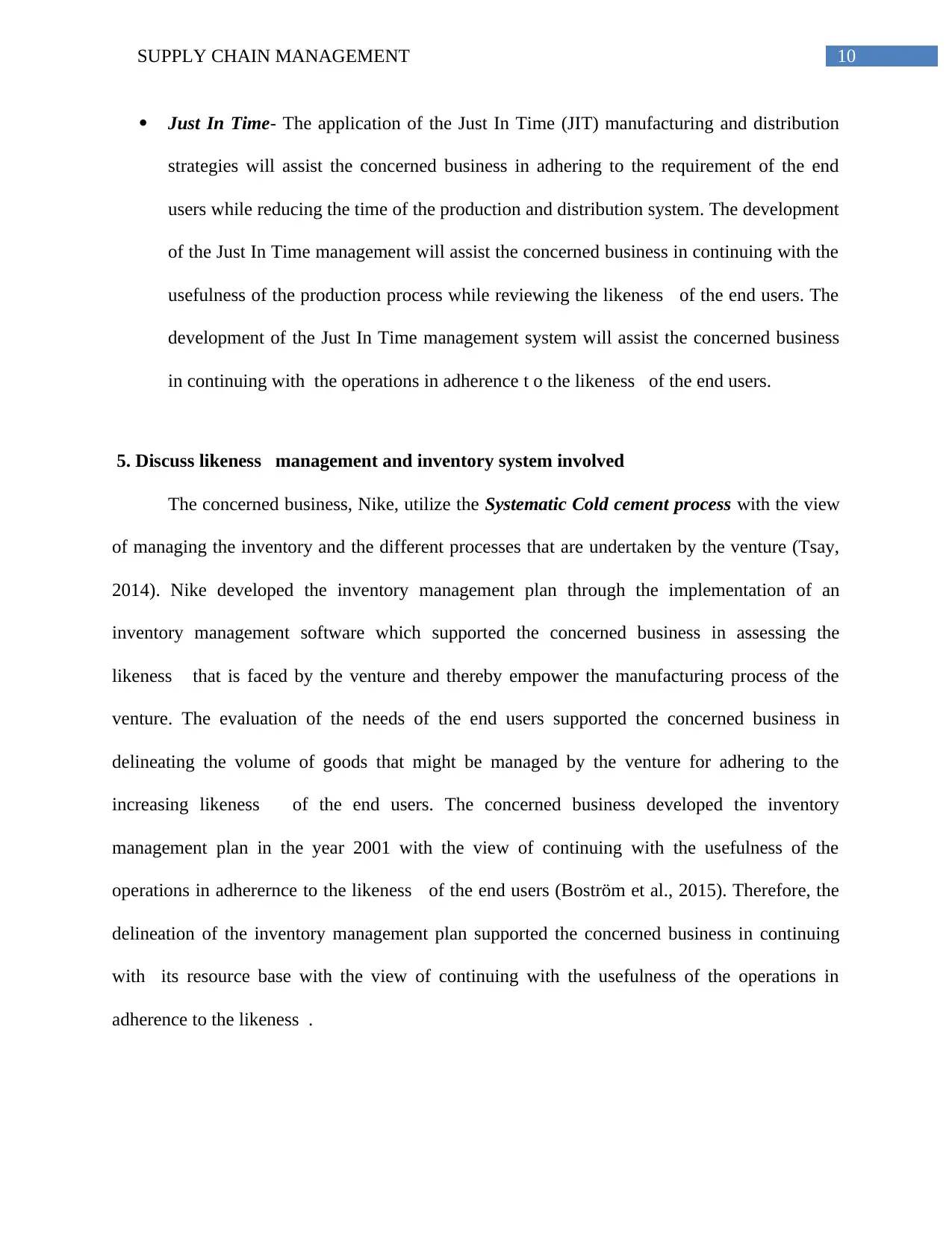
10SUPPLY CHAIN MANAGEMENT
Just In Time- The application of the Just In Time (JIT) manufacturing and distribution
strategies will assist the concerned business in adhering to the requirement of the end
users while reducing the time of the production and distribution system. The development
of the Just In Time management will assist the concerned business in continuing with the
usefulness of the production process while reviewing the likeness of the end users. The
development of the Just In Time management system will assist the concerned business
in continuing with the operations in adherence t o the likeness of the end users.
5. Discuss likeness management and inventory system involved
The concerned business, Nike, utilize the Systematic Cold cement process with the view
of managing the inventory and the different processes that are undertaken by the venture (Tsay,
2014). Nike developed the inventory management plan through the implementation of an
inventory management software which supported the concerned business in assessing the
likeness that is faced by the venture and thereby empower the manufacturing process of the
venture. The evaluation of the needs of the end users supported the concerned business in
delineating the volume of goods that might be managed by the venture for adhering to the
increasing likeness of the end users. The concerned business developed the inventory
management plan in the year 2001 with the view of continuing with the usefulness of the
operations in adherernce to the likeness of the end users (Boström et al., 2015). Therefore, the
delineation of the inventory management plan supported the concerned business in continuing
with its resource base with the view of continuing with the usefulness of the operations in
adherence to the likeness .
Just In Time- The application of the Just In Time (JIT) manufacturing and distribution
strategies will assist the concerned business in adhering to the requirement of the end
users while reducing the time of the production and distribution system. The development
of the Just In Time management will assist the concerned business in continuing with the
usefulness of the production process while reviewing the likeness of the end users. The
development of the Just In Time management system will assist the concerned business
in continuing with the operations in adherence t o the likeness of the end users.
5. Discuss likeness management and inventory system involved
The concerned business, Nike, utilize the Systematic Cold cement process with the view
of managing the inventory and the different processes that are undertaken by the venture (Tsay,
2014). Nike developed the inventory management plan through the implementation of an
inventory management software which supported the concerned business in assessing the
likeness that is faced by the venture and thereby empower the manufacturing process of the
venture. The evaluation of the needs of the end users supported the concerned business in
delineating the volume of goods that might be managed by the venture for adhering to the
increasing likeness of the end users. The concerned business developed the inventory
management plan in the year 2001 with the view of continuing with the usefulness of the
operations in adherernce to the likeness of the end users (Boström et al., 2015). Therefore, the
delineation of the inventory management plan supported the concerned business in continuing
with its resource base with the view of continuing with the usefulness of the operations in
adherence to the likeness .
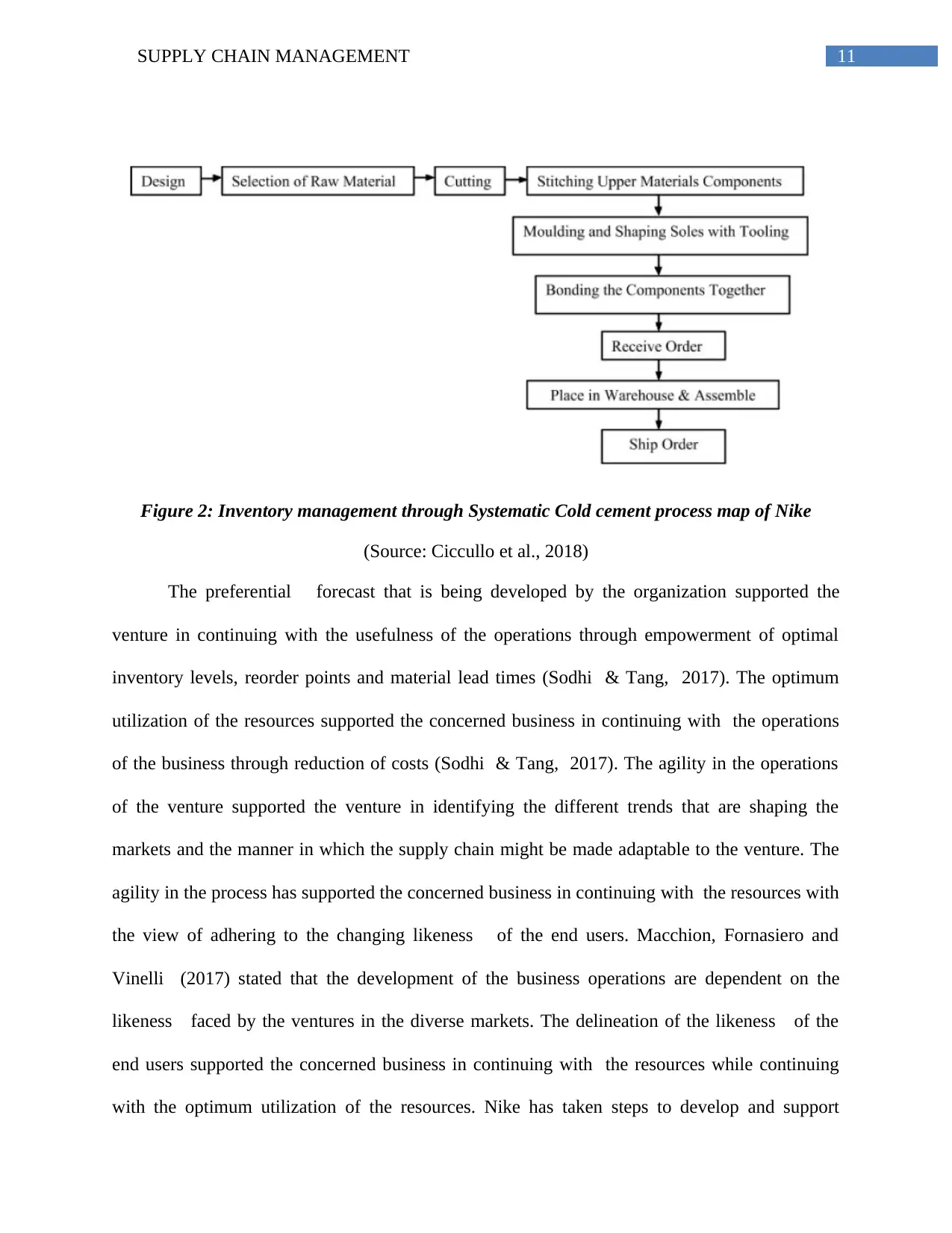
11SUPPLY CHAIN MANAGEMENT
Figure 2: Inventory management through Systematic Cold cement process map of Nike
(Source: Ciccullo et al., 2018)
The preferential forecast that is being developed by the organization supported the
venture in continuing with the usefulness of the operations through empowerment of optimal
inventory levels, reorder points and material lead times (Sodhi & Tang, 2017). The optimum
utilization of the resources supported the concerned business in continuing with the operations
of the business through reduction of costs (Sodhi & Tang, 2017). The agility in the operations
of the venture supported the venture in identifying the different trends that are shaping the
markets and the manner in which the supply chain might be made adaptable to the venture. The
agility in the process has supported the concerned business in continuing with the resources with
the view of adhering to the changing likeness of the end users. Macchion, Fornasiero and
Vinelli (2017) stated that the development of the business operations are dependent on the
likeness faced by the ventures in the diverse markets. The delineation of the likeness of the
end users supported the concerned business in continuing with the resources while continuing
with the optimum utilization of the resources. Nike has taken steps to develop and support
Figure 2: Inventory management through Systematic Cold cement process map of Nike
(Source: Ciccullo et al., 2018)
The preferential forecast that is being developed by the organization supported the
venture in continuing with the usefulness of the operations through empowerment of optimal
inventory levels, reorder points and material lead times (Sodhi & Tang, 2017). The optimum
utilization of the resources supported the concerned business in continuing with the operations
of the business through reduction of costs (Sodhi & Tang, 2017). The agility in the operations
of the venture supported the venture in identifying the different trends that are shaping the
markets and the manner in which the supply chain might be made adaptable to the venture. The
agility in the process has supported the concerned business in continuing with the resources with
the view of adhering to the changing likeness of the end users. Macchion, Fornasiero and
Vinelli (2017) stated that the development of the business operations are dependent on the
likeness faced by the ventures in the diverse markets. The delineation of the likeness of the
end users supported the concerned business in continuing with the resources while continuing
with the optimum utilization of the resources. Nike has taken steps to develop and support
⊘ This is a preview!⊘
Do you want full access?
Subscribe today to unlock all pages.

Trusted by 1+ million students worldwide
1 out of 18
Related Documents
Your All-in-One AI-Powered Toolkit for Academic Success.
+13062052269
info@desklib.com
Available 24*7 on WhatsApp / Email
![[object Object]](/_next/static/media/star-bottom.7253800d.svg)
Unlock your academic potential
Copyright © 2020–2025 A2Z Services. All Rights Reserved. Developed and managed by ZUCOL.





